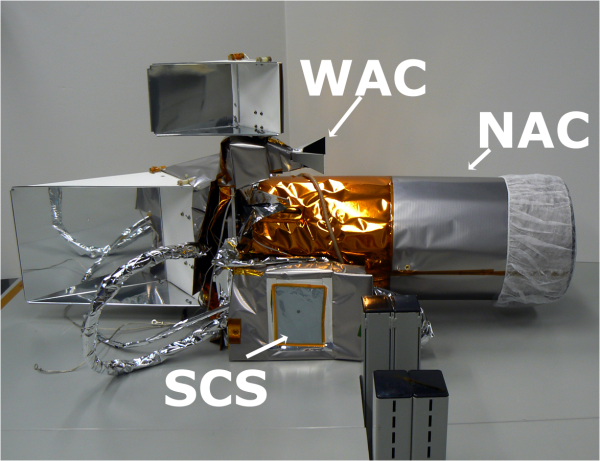
Welcome to the new Lunar Reconnaissance Orbiter Camera (LROC) web page!
The LROC website will share exciting information on LROC's observations of the Moon through its two Narrow Angle Cameras (NAC) and the Wide Angle Camera (WAC). Keep coming back for amazing, up-to-date information about LROC, incredible views of the lunar frontier, virtual tours of the LROC Science Operation Center (SOC), the thrilling history and future of lunar exploration, and fun links to NASA and to our outreach partners at the Adler Planetarium & Astronomy Museum. Right now, the LROC team is busy getting ready for the launch of the Lunar Reconnaissance Orbiter (LRO) mission in June of this year as part of NASA's Lunar Precursor Robotic Program (LPRP). LRO is the first spacecraft to be built as part of NASA's bold new program to return Americans to the surface of the Moon for the first time in a half-century. The LRO spacecraft will be equipped with seven instruments including the Lunar Reconnaissance Orbiter Camera(LROC), the Lunar Orbiter Laser Altimeter (LOLA), the Lunar Exploration Neutron Detector (LEND), the Diviner Lunar Radiometer Experiment (DLRE), the Lyman-Alpha Mapping Project (LAMP), the Cosmic Ray Telescope for the Effects of Radiation (CRaTER), and the Mini-RF. LRO will have a one-year primary mission in a 50km polar mapping orbit. Measurements from LRO will provide much-needed information about the surface of the Moon, potential landing sites for future human and robotic missions, and much more. LROC consists of four major subsystems. There are actually three cameras: Two Narrow Angle Cameras, or NACs, which are designed to take high-resolution (0.5 m/pixel) images of the lunar surface, and a multispectral Wide Angle Camera, or WAC. The last LROC subsystem, the LROC Sequence and Compressor System (SCS), transfers commands from the spacecraft to the camera to acquire image data, and receives and compresses the collected data prior to transmission. For the last several years, the LROC Team has been working really, really, really, really, really hard to get the LROC Instrument ready for the mission. Figure 1, above, shows one of the NAC flight units, the WAC, and the SCS, being tested in the calibration laboratory at Malin Space Science Systems, Inc., during the hardware certification process. Now, after a lot of hard work, LROC is safely mounted aboard the LRO spacecraft, which was recently shipped to Cape Canaveral and is awaiting its launch. While in lunar orbit, the Lunar Reconnaissance Orbiter Camera (LROC) will collect data to meet some vital measurement objectives. First, LROC will collect high-resolution imagery of sites of high scientific interest in order to assess meter-scale features, which will facilitate the selection of future landing sites on the Moon. Second, LROC will acquire images of the lunar poles during every orbit in order to characterize the polar illumination environment (100 meter scale) and identify regions of permanent shadow and permanent or near-permanent illumination over a full lunar year. In addition to these two main objectives, the LROC team plans to conduct meter-scale mapping of the polar regions, collect stereogrammetric data enable derivation of 3-dimensional meter-scale surface features, collect global multi-spectral imaging to map the distribution of the economically-important mineral ilmenite and other lunar resources, and produce a global landform map. LROC images will also be used to map and determine current impact hazards by re-photographing the same regions covered by high-resolution Apollo images in order to provide vital engineering data on lunar impact rates and impactor size to designers working on next-generation human lunar habitats. The United States is going back to the Moon, and this is really cool. The Moon is the perfect place for humanity to learn how to productively and economically live and work on other planets, and the results from the LRO mission are going to provide the key information needed to make it all happen. The LROC Team is tremendously excited about this amazing mission, and we're looking forward to sharing the excitement and wonder of the our first historic steps back to the Moon with the world.
Be sure to come back to this website often for updates and spectacular images of the Earth's "8th Continent" as the results from LROC and the LRO mission pave the way for the epic journey back to the Moon, then on to Mars and beyond!
Published by Samuel Lawrence on 6 March 2009